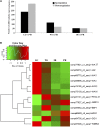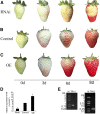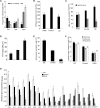Polyamines Regulate Strawberry Fruit Ripening by Abscisic Acid, Auxin, and Ethylene
- PMID: 29523717
- PMCID: PMC5933135
- DOI: 10.1104/pp.18.00245
Polyamines Regulate Strawberry Fruit Ripening by Abscisic Acid, Auxin, and Ethylene
Abstract
Polyamines (PAs) participate in many plant growth and developmental processes, including fruit ripening. However, it is not clear whether PAs play a role in the ripening of strawberry (Fragaria ananassa), a model nonclimacteric plant. Here, we found that the content of the PA spermine (Spm) increased more sharply after the onset of fruit coloration than did that of the PAs putrescine (Put) or spermidine (Spd). Spm dominance in ripe fruit resulted from abundant transcripts of a strawberry S-adenosyl-l-Met decarboxylase gene (FaSAMDC), which encodes an enzyme that generates a residue needed for PA biosynthesis. Exogenous Spm and Spd promoted fruit coloration, while exogenous Put and a SAMDC inhibitor inhibited coloration. Based on transcriptome data, up- and down-regulation of FaSAMDC expression promoted and inhibited ripening, respectively, which coincided with changes in several physiological parameters and their corresponding gene transcripts, including firmness, anthocyanin content, sugar content, polyamine content, auxin (indole-3-acetic acid [IAA]) content, abscisic acid (ABA) content, and ethylene emission. Using isothermal titration calorimetry, we found that FaSAMDC also had a high enzymatic activity with a Kd of 1.7 × 10-3 m In conclusion, PAs, especially Spm, regulate strawberry fruit ripening in an ABA-dominated, IAA-participating, and ethylene-coordinated manner, and FaSAMDC plays an important role in ripening.
© 2018 American Society of Plant Biologists. All Rights Reserved.
Figures








Similar articles
-
Transcriptome profiling of postharvest strawberry fruit in response to exogenous auxin and abscisic acid.Planta. 2016 Jan;243(1):183-97. doi: 10.1007/s00425-015-2402-5. Epub 2015 Sep 15. Planta. 2016. PMID: 26373937
-
Involvement of three annexin genes in the ripening of strawberry fruit regulated by phytohormone and calcium signal transduction.Plant Cell Rep. 2016 Apr;35(4):733-43. doi: 10.1007/s00299-015-1915-5. Epub 2016 Jan 2. Plant Cell Rep. 2016. PMID: 26724928
-
Abscisic acid and sucrose regulate tomato and strawberry fruit ripening through the abscisic acid-stress-ripening transcription factor.Plant Biotechnol J. 2016 Oct;14(10):2045-65. doi: 10.1111/pbi.12563. Epub 2016 May 4. Plant Biotechnol J. 2016. PMID: 27005823 Free PMC article.
-
Update on the Roles of Polyamines in Fleshy Fruit Ripening, Senescence, and Quality.Front Plant Sci. 2021 Feb 10;12:610313. doi: 10.3389/fpls.2021.610313. eCollection 2021. Front Plant Sci. 2021. PMID: 33664757 Free PMC article. Review.
-
Abscisic acid perception and signaling transduction in strawberry: a model for non-climacteric fruit ripening.Plant Signal Behav. 2011 Dec;6(12):1950-3. doi: 10.4161/psb.6.12.18024. Plant Signal Behav. 2011. PMID: 22095148 Free PMC article. Review.
Cited by
-
Copper Amine Oxidase (CuAO)-Mediated Polyamine Catabolism Plays Potential Roles in Sweet Cherry (Prunus avium L.) Fruit Development and Ripening.Int J Mol Sci. 2022 Oct 11;23(20):12112. doi: 10.3390/ijms232012112. Int J Mol Sci. 2022. PMID: 36292969 Free PMC article.
-
Hydrogen Sulfide Maintained the Good Appearance and Nutrition in Post-harvest Tomato Fruits by Antagonizing the Effect of Ethylene.Front Plant Sci. 2020 May 14;11:584. doi: 10.3389/fpls.2020.00584. eCollection 2020. Front Plant Sci. 2020. PMID: 32477391 Free PMC article.
-
Proanthocyanidins Delay Fruit Coloring and Softening by Repressing Related Gene Expression during Strawberry (Fragaria × ananassa Duch.) Ripening.Int J Mol Sci. 2023 Feb 5;24(4):3139. doi: 10.3390/ijms24043139. Int J Mol Sci. 2023. PMID: 36834547 Free PMC article.
-
Widely Targeted Metabolomic Profiling Combined with Transcriptome Analysis Provides New Insights into Lipid Biosynthesis in Seed Kernels of Pinus koraiensis.Int J Mol Sci. 2023 Aug 17;24(16):12887. doi: 10.3390/ijms241612887. Int J Mol Sci. 2023. PMID: 37629067 Free PMC article.
-
The Physiological and Molecular Mechanism of Abscisic Acid in Regulation of Fleshy Fruit Ripening.Front Plant Sci. 2021 Jan 11;11:619953. doi: 10.3389/fpls.2020.619953. eCollection 2020. Front Plant Sci. 2021. PMID: 33505417 Free PMC article. Review.
References
-
- Adams-Phillips L, Barry C, Giovannoni J (2004) Signal transduction systems regulating fruit ripening. Trends Plant Sci 9: 331–338 - PubMed
-
- Agudelo-Romero P, Ali K, Choi YH, Sousa L, Verpoorte R, Tiburcio AF, Fortes AM (2014) Perturbation of polyamine catabolism affects grape ripening of Vitis vinifera cv. Trincadeira. Plant Physiol Biochem 74: 141–155 - PubMed
-
- Agudelo-Romero P, Bortolloti C, Pais MS, Tiburcio AF, Fortes AM (2013) Study of polyamines during grape ripening indicate an important role of polyamine catabolism. Plant Physiol Biochem 67: 105–119 - PubMed
-
- Alexander L, Grierson D (2002) Ethylene biosynthesis and action in tomato: a model for climacteric fruit ripening. J Exp Bot 53: 2039–2055 - PubMed
Publication types
MeSH terms
Substances
LinkOut - more resources
Full Text Sources
Other Literature Sources
Miscellaneous

